Image: The Cerne Abbas Giant, owned by the National Trust. Photo by Pete Harlow, Wikimedia Commons (Creative Commons licence CC BY-SA 3.0).
This post is by Guy Shrubsole. Updated 9th Feb 2020 with more on Richard Drax and Viscount Rothermere.
Dorset is, I think, the loveliest and most intriguing of English counties: a place of ancient chalk downland that sprouts orchids and chalk figures like the Cerne Abbas giant; the epitome of ‘deep England’, the heart of Hardy’s Wessex, whose rich history mixes lost villages, military camps, rural fascists and the origins of Organic farming, all recounted in Patrick Wright’s superlative book The Village that Died for England (1995).
Dorset is also a county dominated by some very large estates. In fact, it turns out, just ten landowners own one-sixth of all Dorset.
Those huge landowners include the proprietor of the Daily Mail, Viscount Rothermere; the MP for South Dorset, Richard Drax; and the Hon. Charlotte Townshend, who is the only landowner besides the Queen permitted to own swans (yes, really).
The most significant of these estates form an almost unbroken arc across east Dorset stretching from Cranborne Chase down to Lulworth Cove. Many of them have been in existence for centuries, frequently in the hands of the same family. As landownership clusters go, they are perhaps comparable to the set of (even larger) estates that dominate the chalk hills of the South Downs National Park, further to the east. (West Dorset, by contrast, is a hotbed of land reformers and rebellious peasants: from the HQ of The Land magazine at Monkton Wyld, to various smallholdings run by founding members of the Land Workers’ Alliance.)
So, here’s the map I’ve made of Dorset’s largest landowners, with a table summarising what they own, followed by more information on each one and how I pieced it together.
Map contains INSPIRE Index Polygons. © Crown copyright and database rights 2018 Ordnance Survey 100026316; published here for purposes of news reporting under fair dealing. I will take them down if requested by OS.
Dorset’s top ten landowners
| Landowner | Estate(s) | Area |
| National Trust | Various – largest is Kingston Lacy | 21,772 acres |
| Richard Drax MP | Charborough Estate | 13,870 acres |
| Weld family | Lulworth Castle Estate | 12,000 acres |
| Hon. Charlotte Townshend | Ilchester Estates (Abbotsbury & Membury Estates) | 11,327 acres |
| Ministry of Defence (MOD) | Bovington Camp, Blandford Camp, Lulworth Range | 11,304 acres |
| Crichel Dorset Holdings / Richard Chilton (US billionaire) | Crichel Down Estate | 7,932 acres |
| Marquess of Salisbury | Cranborne Estate | 7,796 acres |
| Pitt-Rivers family | Rushmore Estate | 7,500 acres |
| Earl of Shaftesbury | Shaftesbury (Wimborne St Giles) Estate | 5,700 acres |
| Viscount Rothermere (Daily Mail proprietor) | Bryanston Estate | 4,700 acres |
| Total
Total area of Dorset Percentage owned by top 10 landowners |
103,901 acres | |
| 655,570 acres | ||
| 15.8% | ||
1) The National Trust – 21,772 acres
Perhaps unsurprisingly for a county so rich in history and natural beauty, the National Trust is Dorset’s largest institutional landowner – encompassing long stretches of the fossil-filled Jurassic Coast, a big chunk of the beautiful Isle of Purbeck, and (largest of their Dorset properties) the mansion and estate of Kingston Lacy.
2) Richard Drax MP – 13,870 acres
Richard Drax – or to give him his full name, Richard Grosvenor Plunkett-Ernle-Erle-Drax – is the MP for South Dorset, owner of the Charborough Estate, and by my reckoning, the largest individual landowner in Dorset. Drax’s ancestors, notoriously, were involved in the slave trade, owning plantations in Barbados, and received compensation from the British government when slavery was finally abolished.
Drax’s extensive estate is now well-known – especially its immensely long boundary wall, composed of two million bricks, which cars speeding down the A31 regularly crash into.
But the Charborough Estate’s website is stonily silent about the full extent of Drax’s landholdings. Wikipedia states it to be 7,000 acres, citing a Daily Mail article from 2009. But this appears to be a considerable underestimate.
To investigate further, I checked a variety of sources. Environmental Stewardship (ES) maps show a few small relevant patches of land in receipt of these green farm subsidy schemes – to Jeremy R Drax (Richard’s brother and a London property magnate), who appears to have a stately pad by the coast and is getting paid £853,547 to keep the surrounding farmland in good stewardship – and to ‘Mr H W Drax’s 1962 Discretionary Trust’, a Drax family trust. But neither show anything like the full Drax estate.
I tried HMRC’s database of estates granted tax breaks for heritage reasons (hereafter ‘HMRC maps’) but nothing showed up for the Charborough Estate. I had a look on some paid-for tools which map Land Registry corporate and commercial landowner data, but the land titles for the Charborough Estate are all registered to individuals and trusts, not to companies.
But then I had a look at Dorset Council’s Highways Act s31 landowner deposits, and – after missing them initially, because they weren’t named as being the Charborough Estate – I found four maps of the estate (LD41/1, LD42/1, LD43/1 and LD44/1). From these we can see much of the land is registered in two trusts: ‘Richard Drax’s 1987 Accumulation and Maintenance Settlement’, and ‘Admiral Drax’s Dorset and Lincs Trust’ (which suggests there is also a Lincolnshire estate still, somewhere). Such trusts are often used by large estates to ensure inheritance remains in the family line and for reasons of ‘tax efficiency’.
I then recreated these digitally using GIS software, and measured the area: at some 13,870 acres, Richard Drax MP appears to own almost twice as much as previous public estimates. And that’s not even counting his brother’s coastal pad.
Indeed, looking at this 1883 summary of the Victorian Return of Owners of Land, Drax’s ancestors appear to have owned even more land – not only in Dorset, but also in Lincolnshire, North Yorkshire and elsewhere:
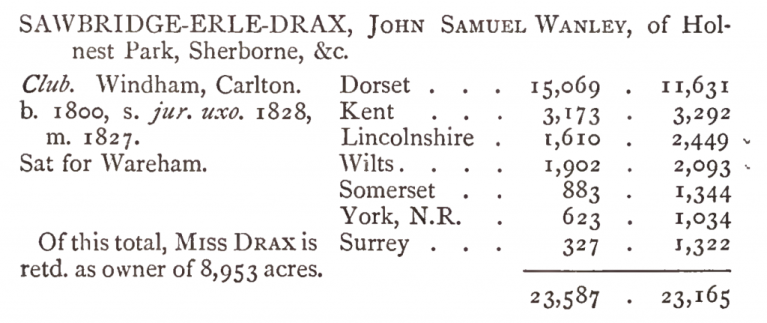
3) Weld Family – 12,000 acres
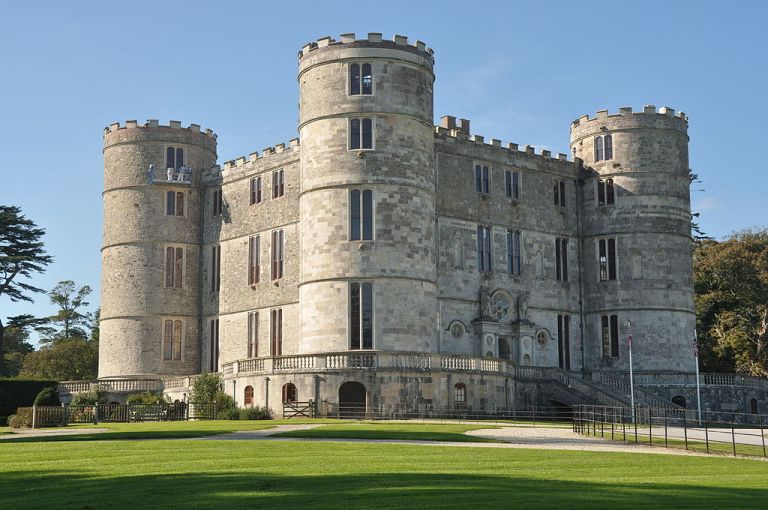
Image: Lulworth Castle – by Nilfanion, Wikimedia Commons (CC BY-SA 4.0).
The Lulworth Estate is perhaps best known for its impressive castle and for hosting Camp Bestival each summer. It’s been owned by the Weld family since 1641 and covers a great sweep of farmland reaching from the decommissioned nuclear site at Winfrith down to the coast and Lulworth Cove.
During the 1920s, the War Office’s Tank Corps, who had been using the chalk downland above Arish Mell for firing practice, sought to consolidate their position in the area by compulsorily purchasing the land from the estate. But the Welds and neighbouring aristocracy were having none of it, and waged the ‘defence of Arish Mell’ against the encroaching power of the State, as they saw it. They managed to resist having to sell the freehold of the land to the War Office, but had to make do with a long lease, which remains to this day – the site of the MOD’s Lulworth Camp.
The polygons I’ve pieced together (from ES maps – payments to ‘Lulworth Castle Farms’; English Woodland Grant Scheme maps – payments to ‘The Weld Estate’; and Land Registry corporate & commercial data for Lulworth Estate Trustees Ltd), sum to 11,500 acres; the estate website says it spans over 12,000 acres, so I’ve gone with this slightly higher figure.
4) Hon. Charlotte Townshend – 11,327 acres
The Hon. Charlotte Townshend, one of the richest people in the South West, owns the Ilchester Estates – which in Dorset encompass Abbotsbury (a large swathe of farmland along the coast as well as a big part of Chesil Beach, of Ian McEwan and pebbles fame); and Melbury, a stately home and surrounding parkland further inland.
Her estates are often stated to be around 15,000 acres, but measuring the maps I’ve derived from two s31 landowner deposits (here and here) gives a slightly smaller figure of 11,327 acres. I suspect that the Hon. Charlotte Townshend certainly owns 15k acres across the country, however – it’s just that some of this is to be found in her other landholdings beyond Dorset: such as a 3,000-acre Nottinghamshire estate, a grouse moor in the North Pennines, and a chunk of uber-expensive Holland Park in London. Oh yes, and swans.
5) Ministry of Defence – 11,304 acres
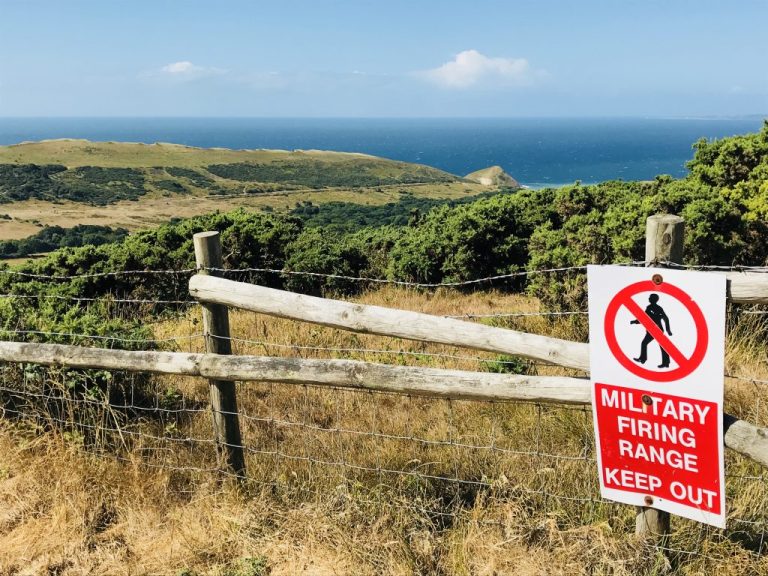
Image: the view down towards Tyneham on the Isle of Purbeck, taken by me one summer looking over the MOD’s barbed wire fence – which I then ripped my knee open on trying to get a better view.
The military’s impact on Dorset during the 20th century has been extensive. The MOD’s presence endures today in a number of significant sites: Blandford Camp; Bovington Camp with its Tank Museum; and the Lulworth Ranges.
The last of these are the largest and have perhaps the most controversial history. They began to be used for firing ranges during WWI, but it was during WWII that the War Office decided it needed to take over the whole area and remove the remaining residents. In the firing line was Tyneham, the ‘village that died for England’, whose residents were evacuated but given the promise that they would be able to return to their homes after hostilities ceased – a promise that has never been honoured. To this day Tyneham remains a shell, a ghost village, nestled in a valley that time has forgotten. It is now open to the public though – a concession made by the MOD after decades of campaigning. It’s a strange, weird sight, beautiful and eerie at the same time, even on a hot summer’s day.
Incidentally, the former owners of Tyneham Manor – the Bond family – helped provide the inspiration for Ian Fleming’s 007 spy novels. Fleming lived in Dorset for a while, where he also encountered the Drax family (owners of the aforementioned Charborough Estate). In their honour, Fleming named his arch-villain Hugo Drax. So, you could say that the pattern of land ownership in Dorset gave us James Bond. (Thanks to Miles King for this local history!)
6) Crichel Down Estate – 7,932 acres
Crichel Down is also indelibly associated with World War Two and the requisitioning of land, for 700 acres of it had been taken by the Air Ministry for training, and then not given back at the end of the war. The subsequent legal and political battle was complicated (I explain it in more detail in my book) but in a nutshell the aristocratic owners of the Crichel Down Estate got their land back whilst the villagers of Tyneham didn’t, and in so doing, changed the rules forever on how governments dispose of land they’ve compulsorily purchased – marking the high water mark of the expansive State.
What of the Crichel Down Estate today? In 2013, the house and at least some of the estate was bought by an American billionaire, Richard Chilton, and vested in his US-registered firm, Crichel Dorset Holdings LLC. But who owns the rest of the estate remains very unclear. There are at least three companies who own parts of the Crichel Down estate and whose freehold land parcels actually overlap with one another – Crichel Dorset Holdings LLC, Crichel Properties Ltd (the Person of Significant Control lists their job title as ‘Estate Manager’, rather than owner), and Coppid Farming Enterprises LLP, which appears to be controlled by Baron Phillimore. Until someone can clear up the mystery, I’ve included them all as a single estate (polygons identified using Land Registry corporate & commercial dataset).
7) Marquess of Salisbury – 7,796 acres
I’ve written in more detail about the Marquess of Salisbury’s estates before – like his other estate at Hatfield, much of the Cranborne Estate in Dorset is registered offshore, to Jersey-based Samos and Mysia Investments, and Bahamas-registered Syros Investments. Maps for this come from Private Eye’s offshore property dataset, coupled with ES maps (farm payments to ‘Cranborne Farms’, ‘Marquess of Salisburys Estates’) and this s31 landowner deposit map.
8) Pitt-Rivers family – 7,500 acres
General Augustus Henry Lane-Fox Pitt Rivers was an army officer and Victorian anthropologist whose name is perhaps best known from the Pitt Rivers Museum in Oxford (its collection of trepanned skulls features in Philip Pullman’s His Dark Materials). In 1880 he inherited the Rushmore Estate from his cousin and also his surname (up until that point he had been plain old Lane-Fox). His grandson, Captain George Lane-Fox Pitt Rivers, was one of the wealthiest men in Britain during the 1930s and a big Nazi sympathiser – one of Dorset’s rural fascists described by Patrick Wright – and also led local campaigns to abolish Church tithes on rural land (they finally went in 1936).
In 2015 there was something of a family feud over who would inherit (internet entrepreneur Martha Lane Fox and Olympic equestrian William Fox-Pitt are both current family members, for instance) but checking a land title it looks like a joint family trust now presides over the Rushmore Estate – one of the trustees is George Anthony Lane Fox Pitt Rivers. Here’s the s31 landowner deposit which allowed me to map the present estate. Rushmore Farms have had an Environment Stewardship scheme with DEFRA to the tune of almost £1m. The estate also benefits from tax breaks agreed under HMRC’s tax-exempt heritage assets scheme. It sounds like the Pitt Rivers family may also own other estates around nearby Hinton St Mary, but I’ve not been able to track down any maps.
9) Earl of Shaftesbury – 5,700 acres
The Earl of Shaftesbury owns the Wimborne St Giles estate, in between Crichel Down and the Cranborne Estate. I mapped it by using English Woodland Grant Scheme maps and matching these up to corresponding land parcels. The Earl has also courted controversy in recent years by dredging sand from the environmentally sensitive Lough Neagh in Northern Ireland, which the Shaftesbury Estate owns.
10) Viscount Rothermere – 4,700 acres
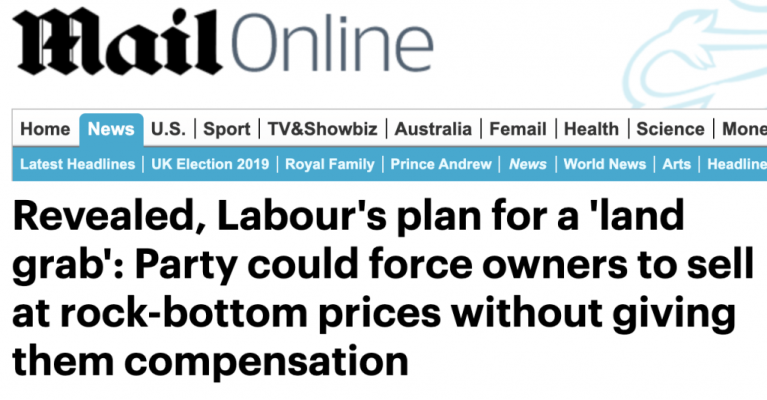
The Daily Mail: not a fan of land reform.
Last but by no means least, we arrive at Viscount Rothermere – proprietor of the Daily Mail (and who recently also acquired the i newspaper). Jonathan Harmsworth, the current Viscount, bought Ferne Park on the Dorset-Wiltshire border in 2002 and proceeded to rebuild the mansion (Google Earth images below show how busy he’s been).
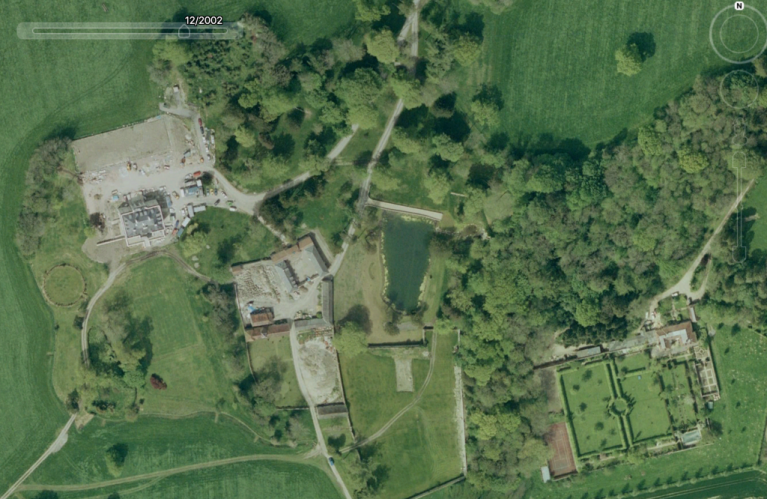

Intriguingly, some of the land around Ferne Park (though not the house itself) is registered to Harmsworth Trust Company (PTC) Ltd, based in the British Virgin Islands – a well-known tax haven. What, if any, tax benefits this confers on the owner is unknown. Private Eye, reviewing the Viscount’s tax status and offshore holdings some years ago, suggested that “For a non-dom, even land deep in the English countryside ultimately escapes inheritance tax if held through offshore trusts”. This, of course, would be perfectly legal.
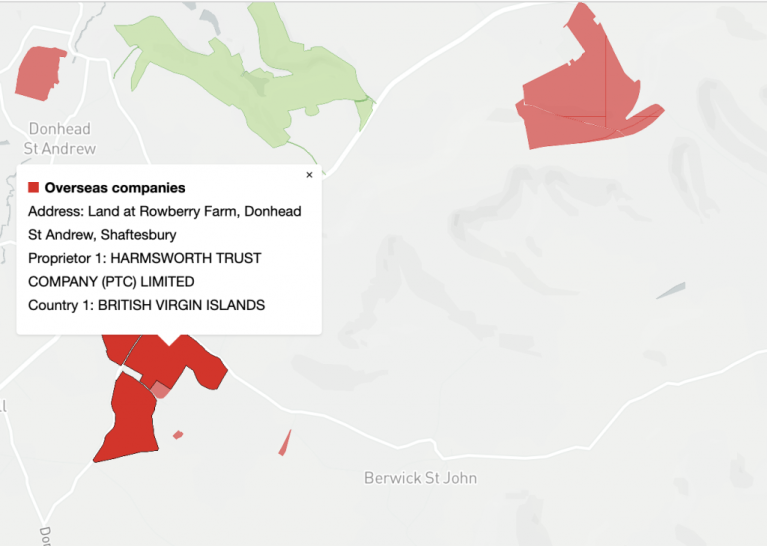
Then, in 2015, Viscount Rothermere acquired the 4,700-acre Bryanston Estate in Dorset from the Crown Estate. The Crown Estate’s press release states it was sold “to a UK company held on behalf of the Viscount Rothermere and his son the Hon Vere Harmsworth for an undisclosed sum” (update: see below for what that sum was). That UK-based company, it transpires, is called Bryanston (RFE) Ltd: and though its Companies House accounts here confirm it is registered in the UK, its latest 2018 accounts show that its immediate shareholders are two Jersey-based firms (screengrab below). Again, no wrongdoing is suggested, and it is unclear what if any implications this has for the estate’s tax status.

A map of the estate is shown below.
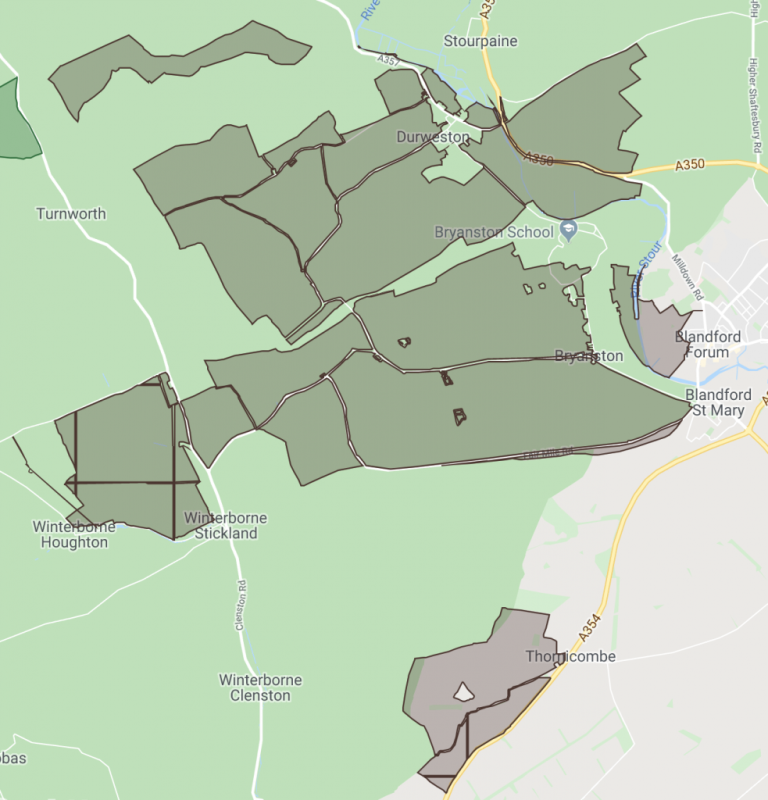
Ironically, given his paper’s hatred of the European Union, Viscount Rothermere has done well out of the EU farm subsidy system. ‘Lord Rothermere T/A Ferne Park Estate’ received £57,304 in CAP payments in 2018. Though Bryanston (RFE) Ltd does not appear to get any such farm subsidies directly, the tenant farmers who work the estate’s land do. ‘Hosford, J H R’ has an Environmental Stewardship agreement in place for land covering much of the Bryanston Estate, and in 2018 received £244,298 in overall farm subsidies (screengrabs below). Such income will likely be factored into the rents that Bryanston (RFE) Ltd charge their tenants.


Update: I FOI’d the Crown Estate for details of the sale of the Bryanston Estate back in 2015. Their response to me revealed the sale price was £43m. The three documents they released to me are linked to below:
- Business case for sale of Bryanston Estate with sale price
- Valuation of each part of the Bryanston Estate
- Map of the Bryanston Estate (though doesn’t show unregistered land)
Total: 10 landowners, 103,901 acres, one-sixth of all Dorset
Post-script: other Dorset landowners
Big thanks to friends and readers who have sent over info on other Dorset estates, particularly Miles King. My biggest omission from the above list was the Sherborne Estate in north Dorset, rumoured to be 13,000 acres; I’d previously spotted it but couldn’t find a map or corroborate the area. Another omission was the c6,000 or so acres owned by Dorset County Council, mostly in the form of County Farms.
I’ve compiled known details of other Dorset landowners shared with me in this Googledoc; if you can add to it further, please post in the comments section below.



Domnic Cummings is spouting on about oddballs and misfits required for the civil-service & championing himself as a ‘once in a generation’ reformer in government. What are his chances of doing anything about land-reform, even if he was willing which I very much doubt…
LikeLike
His wife and family are landowners
LikeLike
It was interesting to read in The Land Magazine a few years ago that Dorset was a hotbed of rural unrest in the late Victorian period and there were constant demands for more Police in the area
LikeLike
Maybe the Lincs bit of the Admiral Drax’s Dorset & Lincs Trust is around Sibsey https://discovery.nationalarchives.gov.uk/details/r/C3709799
LikeLike
Drax lands in Lincolnshire: I think it is around Sibsey, but here is the only online record I have ever found (so far) https://discovery.nationalarchives.gov.uk/details/c/F20707
LikeLike
While not in the top ten, there is this 2100 acre estate owned by the Ernest Cook Trust.
http://ernestcooktrust.org.uk/the-trusts-estates/dorset-the-trent-estate/
LikeLike
In addition, as the main land ownership map on the Who Owns England site shows, a major landowner in Dorset is the Forestry commission, which almost cetainly is large enough to include in the list.
LikeLike
Stock Gaylard Estate (1600 acres):
http://www.visitukheritage.gov.uk/servlet/com.eds.ir.cto.servlet.CtoLandDetailServlet?ID=608
LikeLike
My understanding is that the Drax estate includes many times the landholding area in Dorset with territory in NE of England as well as property in Barbados where family predecessors so successfully enforced misery and suffering to the 300, 000 black African slaves brought in chains to work the sugar plantations. -Strange that no reparation has every been made to their successors even though the Drax successors still lead a life of relative privilege and political influence. DORSET continues to have the least investment in infrastructure of pretty much any other county in England.
LikeLike
This is really interesting; thanks for digging and for sharing. I wonder whether you have any information on how the land was acquired? I realise that’s likely to be a herculean task, but specifically I’m wondering how much of it was acquired through enclosure? It would be interesting, in particular, to see what connections there might be between forcible land acquisition and usage abroad (in Barbados, let’s say) and similar behaviours in the UK.
LikeLike
Many years ago I found this info: William Blackmore was owner of 7 acres and 20 perches (7.32 acres) as recorded in 1873 a book which recorded all owners of lands of one acre or more Volume one of the book Owners of Lands in Dorset, so it was not a large farm.(a perch was considered to be 1/640th of an acre) the farms estimated value was 48 pounds 5 shillings. Could you tell me who owns this property now, I assume it has been absorbed into one of the bigger estates.
LikeLike
I’d be ecstatic if I had 1 acre.
LikeLike
“I’ve compiled known details of other Dorset landowners shared with me in this Googledoc; if you can add to it further, please post in the comments section below.”
One omission is the Duchy of Cornwall. Kevin Cahill (2001) gives a figure for Dorset of 3,600 acres. Extensive details appear in Crispin Gill’s ‘The Duchy of Cornwall’ (1987). The 3,000 acre Fordington estate is in south Dorset, round the east, south and west of Dorchester. It includes Maiden Castle, and Prince Charles’ pet architectural project, Poundbury. The Mere estate is mostly in Wiltshire but extends into north Dorset near Gillingham. Dorchester and Gillingham have both seen substantial housing growth and the Duchy is likely to have done well out of it.
LikeLike
Hi
Do you know who the major landowner is for Ashmore, Dorset?
Thank you.
LikeLike